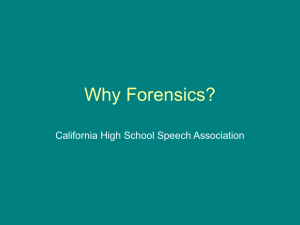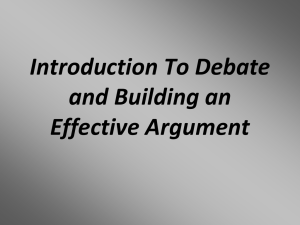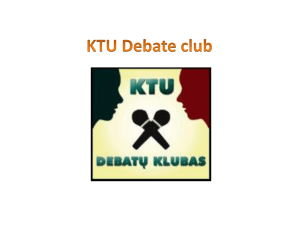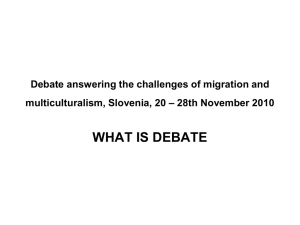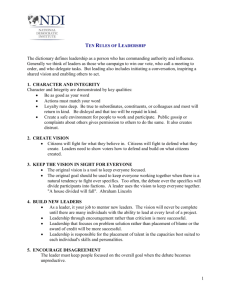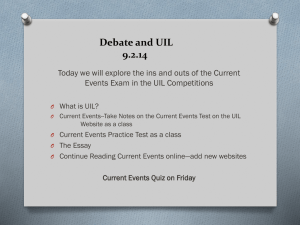Speech # 2: Information or Demonstration. 50 pts/15 pt outline on
advertisement
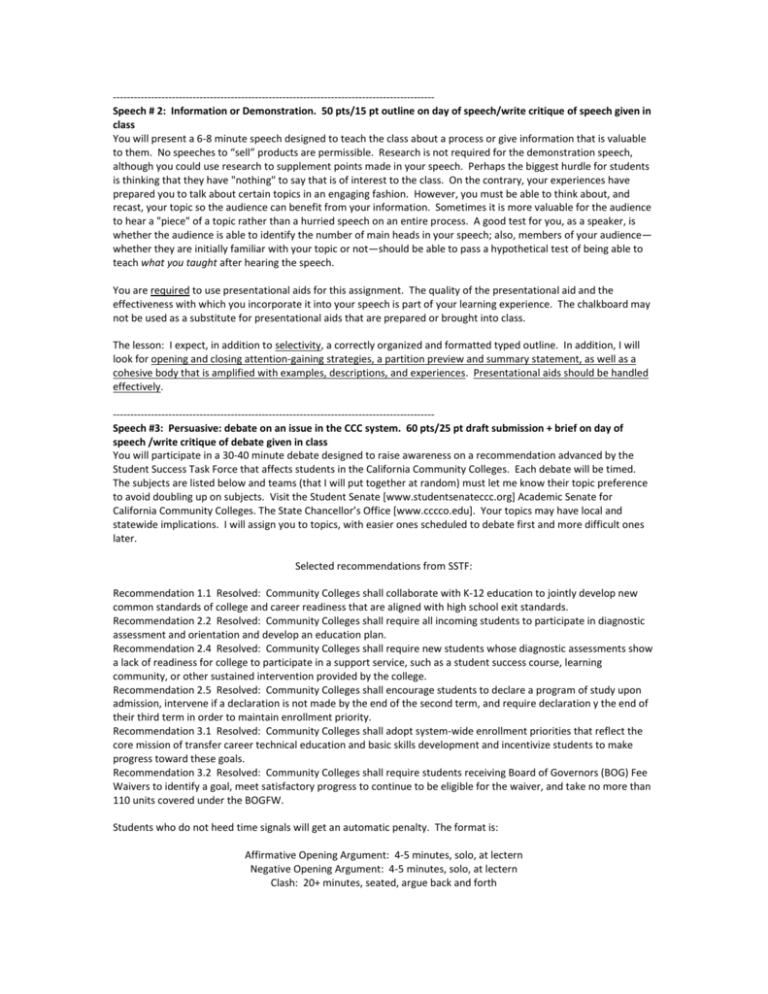
--------------------------------------------------------------------------------------------Speech # 2: Information or Demonstration. 50 pts/15 pt outline on day of speech/write critique of speech given in class You will present a 6-8 minute speech designed to teach the class about a process or give information that is valuable to them. No speeches to “sell” products are permissible. Research is not required for the demonstration speech, although you could use research to supplement points made in your speech. Perhaps the biggest hurdle for students is thinking that they have "nothing" to say that is of interest to the class. On the contrary, your experiences have prepared you to talk about certain topics in an engaging fashion. However, you must be able to think about, and recast, your topic so the audience can benefit from your information. Sometimes it is more valuable for the audience to hear a "piece" of a topic rather than a hurried speech on an entire process. A good test for you, as a speaker, is whether the audience is able to identify the number of main heads in your speech; also, members of your audience— whether they are initially familiar with your topic or not—should be able to pass a hypothetical test of being able to teach what you taught after hearing the speech. You are required to use presentational aids for this assignment. The quality of the presentational aid and the effectiveness with which you incorporate it into your speech is part of your learning experience. The chalkboard may not be used as a substitute for presentational aids that are prepared or brought into class. The lesson: I expect, in addition to selectivity, a correctly organized and formatted typed outline. In addition, I will look for opening and closing attention-gaining strategies, a partition preview and summary statement, as well as a cohesive body that is amplified with examples, descriptions, and experiences. Presentational aids should be handled effectively. --------------------------------------------------------------------------------------------Speech #3: Persuasive: debate on an issue in the CCC system. 60 pts/25 pt draft submission + brief on day of speech /write critique of debate given in class You will participate in a 30-40 minute debate designed to raise awareness on a recommendation advanced by the Student Success Task Force that affects students in the California Community Colleges. Each debate will be timed. The subjects are listed below and teams (that I will put together at random) must let me know their topic preference to avoid doubling up on subjects. Visit the Student Senate [www.studentsenateccc.org] Academic Senate for California Community Colleges. The State Chancellor’s Office [www.cccco.edu]. Your topics may have local and statewide implications. I will assign you to topics, with easier ones scheduled to debate first and more difficult ones later. Selected recommendations from SSTF: Recommendation 1.1 Resolved: Community Colleges shall collaborate with K-12 education to jointly develop new common standards of college and career readiness that are aligned with high school exit standards. Recommendation 2.2 Resolved: Community Colleges shall require all incoming students to participate in diagnostic assessment and orientation and develop an education plan. Recommendation 2.4 Resolved: Community Colleges shall require new students whose diagnostic assessments show a lack of readiness for college to participate in a support service, such as a student success course, learning community, or other sustained intervention provided by the college. Recommendation 2.5 Resolved: Community Colleges shall encourage students to declare a program of study upon admission, intervene if a declaration is not made by the end of the second term, and require declaration y the end of their third term in order to maintain enrollment priority. Recommendation 3.1 Resolved: Community Colleges shall adopt system-wide enrollment priorities that reflect the core mission of transfer career technical education and basic skills development and incentivize students to make progress toward these goals. Recommendation 3.2 Resolved: Community Colleges shall require students receiving Board of Governors (BOG) Fee Waivers to identify a goal, meet satisfactory progress to continue to be eligible for the waiver, and take no more than 110 units covered under the BOGFW. Students who do not heed time signals will get an automatic penalty. The format is: Affirmative Opening Argument: 4-5 minutes, solo, at lectern Negative Opening Argument: 4-5 minutes, solo, at lectern Clash: 20+ minutes, seated, argue back and forth Negative Closing Argument: 4-5 minutes, solo, at lectern Affirmative Closing Argument: 4-5 minutes, solo, at lectern Please note that, if for logistical reasons there are more than two debaters per team, each debater must nevertheless present one speech at the lectern. Debaters must research both sides of the issue. Whether you represent the affirmative or negative position will be determined on the day of the debate; you will have 5 minutes to discuss strategy with your debate partner. Opening arguments are mini persuasive speeches that highlight the major arguments for the proposition and the closing arguments summarize why we, the audience, should agree with your side of the debate. Both opening and closing arguments MUST present at least two claims (given the time constraints, selecting two is judicious) and introduce effectively at least two pieces of evidence. Opening and closing statements are given at the lectern. However, while you will have prepared outlines in the brief, ONLY the opening affirmative speaker will have a chance to use a prepared outline; all following speakers should take notes and then modify their remarks based on what has been stated before. In other words, this is true extemporaneous speaking. During the clash, all are seated and you are free to argue back and forth on the issue with the only guideline being to cite sources when making arguments that include claim, evidence, and reasoning. During this portion of the debate, you may cross-examine your opponents’ claims and advance arguments of your own. Address comments during the clash to the audience, not to your opponents. Do not raise your voices or attack each other rather than the issue. No reschedules permitted for the debate. If a debater is absent, there is no way to make up this assignment. If a debater is late, we will begin without you. If you lose your partner, your new responsibilities—and how you are graded in the debate—will be adjusted accordingly. The lesson: In addition to the criteria stated in the informative speech, the policy debate should be free of logical fallacies. Cite evidence appropriately and effectively. The opening and closing arguments, as well as the clash, should be extemporaneous (no reading from a manuscript) Each pair of debaters must turn in one BRIEF at the end of the debate; so, for your debate topic, I should receive two briefs. Brief should reflect the debaters’ preparation and strategies; identical briefs are unacceptable. The brief contains these elements and will be graded according to completeness and correctness: 1. 2. 3. 4. 5. 6. A properly worded proposition. Outlines of opening & closing aff & neg speeches; make sure 2 pieces of evidence are cited—this means you should indicate on the outline and then state where you got the information from; for partners of 2, this means your brief should contain 4 outlines. A matrix of arguments and counterarguments on the pro and con sides—the more comprehensive, the better. Key important “quotable” or important quotations for pro and con sides. A correctly executed bibliography following MLA or APA guidelines. At least two articles, in their entirety, that were cited in the bibliography. This assignment will give some practice in being prepared to speak in both formal and informal ways--while avoiding memorization. You will probably think harder than you have for other speeches, and you will think on your feet. At the end of all debates, the class will forward a resolution on one issue to a relevant person, entity, or publication. --------------------------------------------------------------------------------------------Speech #4: Local Hero Speech. 25 pts/15 pt outline on day of speech You will present a 5 minute epideictic speech honoring a specific person. You will pay tribute to a local community "hero" you admire. The person may be a peer counselor, Red Cross worker, a physically challenged friend, local merchant, parking lot attendant, a rabbi, teacher, a friend who has been clean and sober, a cashier, etc. It is often helpful to "get to know" the local hero by interviewing him or her or someone who knows the hero. Choose a local "no name" hero because of their character and abilities--not their celebrity status. Please try not to choose family members, as I would like you to think about those outside your family circle and what they do for you. However, if you feel you wish to speak about a family member, that is fine, too—I just want you to do some soul-searching before making your choice. This is a formal speech of tribute that asks that you incorporate some artistic language in the presentation. The lesson: Excellence should be evident in all areas in this speech, but particularly in delivery. In addition to earlierstated requirements of selectivity, organization (intro, body, conclusion), work on eye contact, body language, fluency, enthusiasm. Incorporate stylistic devices in this ceremonial speech. --------------------------------------------------------------------------------------------Exams. 65/65 pts ea. There will be one midterm exam and one comprehensive final exam. In much of the class curriculum, you will receive support so that you can give effective speeches, produce sound outlines, and write thorough critiques. I expect you to work with the text on your own; in my own studies, I go over assigned readings at least three times--first to skim the material, then to read for substantive points, finally, to take notes and compare with class material. Please note that I tend to test things covered in class as opposed to testing arcane information from the textbook. We will explore many activities in class, and it is important during these moments to think about concepts and theories mentioned in class and covered in your text. In other words, look for every possible opportunity to "review" class material. In covering class material, I can get a sense of whether you have been reading, remembering, and applying the material—activities which will help you earn a better grade when you’re tested on conceptual material. Pop Quizzes. 10 pts ea x 2/20 pts max. Please pay attention to instruction in class and complete assigned readings prior to class. Quizzes cannot be made up; you have to be there, in class and on time, to take them. Latecomers may miss the opportunity to take the pop quiz. --------------------------------------------------------------------------------------------Lab Visits and Assignments. Required lab assignments are based on viewing your in-class video to submit a typed critique—please note due dates. You must drop off lab assignments in the Speech Lab or electronically mail them by the due date. ALL lab assignments must have: Your full name Your professor’s name Your class and time it meets G# Kaitlyn Chow Professor Kate T/TH 9:45 am G0000101 If you email assignments, you MUST have this information on your subject line or you will not receive credit. All email submissions will receive a return receipt from a lab instructor. If you have not received a reply in a timely fashion, please FORWARD your original email to the lab so we can verify the date of submission and evaluate the assignment. --------------------------------------------------------------------------------------------Assignments Speech Lab: For schedule, please visit www.collegeofsanmateo.edu/speech You will need to view your first three recorded speeches in the Speech Lab and write an analysis. Modules for critiquing each of these three speeches (all different) are available in the lab but may be downloaded from collegeofsanmateo.edu/speech. In addition, any student may complete two additional lab assignments for a maximum of 10 pts extra credit total; some extra credit assignments are available on the department website [collegeofsanmateo.edu/speech]. Other lab assignments are available only in the lab. You may complete as many lab assignments as you like for practice. Often, these assignments correlate with what has already been covered in class and serve as a useful review. You may download the SPCH 100 review sheet for the midterm and final as early as you wish. You may submit your completed lab assignment to the lab instructors. (When you turn it in, please include your name, course number, and instructor.) If there is time, he or she will discuss the assignment with you, grade it (0-5 pt scale), and keep it in a folder in the lab; it is advisable for you to have the instructor sign your personal copy of the course syllabus with the points received, too. You may also submit your completed lab assignment to the Speech Lab via email: csmspeechlab@smccd.edu. In the subject line, include your name, course number, and instructor. Attach your assignment AND copy and paste it to your email. You will ALWAYS receive a reply from the lab instructor, saying it was received. If no reply is received within a few days, speak with a lab instructor. Your grade (0-5pt scale) will be recorded in a folder in the lab. Grading Scale 355.5 - 395 = A Exceptional, substantive, original work 316 - 355 = B Very good, capable fulfillment of work 276.5 - 315 = C Good work that omits assignment criteria 237 - 276 = D Work doesn’t meet most assignment criteria Below 236 = F Unacceptable work does not meet assignment criteria

